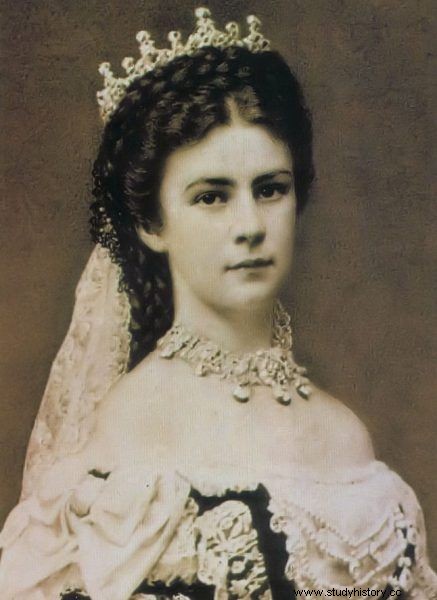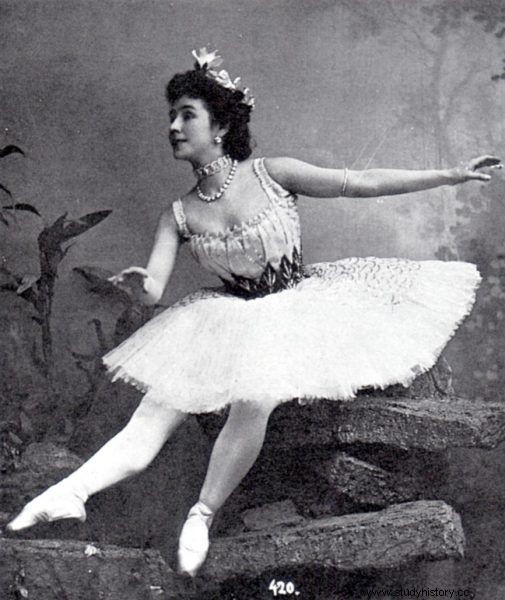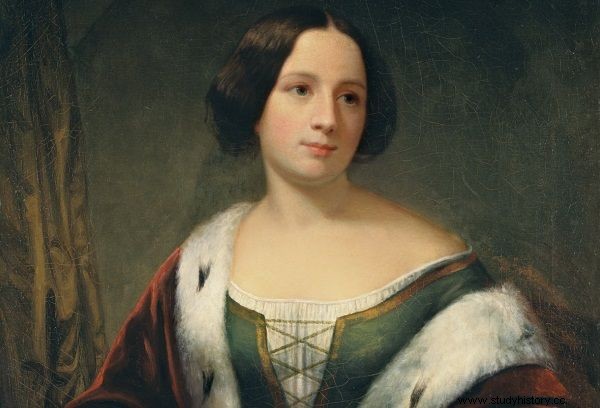There are almost as many lists of the most beautiful women of the 19th century as there are ladies on them. This title was generously awarded to actresses, dancers and noblewomen. Usually, however, it was an illusory ennoblement, and the "distinguished" beauties were treated as objects. Here are three of them who have fallen victim to their own beauty.
Umberto Eco begins his monograph on the history of beauty by saying that we usually use the adjective "beautiful" when we want to express that we like someone or something, arouse our admiration and interest. On the other hand, beauty has been associated with women for centuries, calling them the beautiful sex. Men, on the other hand, played the role of judges and observers, admiring the subject of their fascination. As noted by Laura Mulvey, media scholar at the University of London, over the centuries it was precisely this dynamics that shaped male-female relationships, putting ladies as objects .
Receiving the title of "the most beautiful" was by no means an ennoblement - especially from the perspective of those women who lived in the 19th century. On the one hand, it was a time of significant changes in the moral sphere, on the other, the patriarchal system was still doing well. Focusing solely on the beauty and not the abilities or intelligence of the ladies in a veiled way reminded that in this world of expanding possibilities, they are still the passive side - judged, not judging.
For some of them the "beauty" patch became a yoke that turned their lives into a streak of anguish others managed to use it for their own purposes - and made it to the top. But they also had to pay a high price for it. Here are three women for whom beauty turned out to be a blessing on the one hand and a curse on the other.
Sisi - beauty in shackles
Elizabeth of Bavaria, commonly known as Sisi, is considered in the mass imagination as one of the most beautiful women not only in the 19th century, but in the entire history of mankind. At the same time, he is one of those characters whose true face has been obscured by pop culture. Today, there is talk of her fairy-tale life at the Viennese court rather than the fact that she was one of the most unfortunate empresses in history.

The beauty of the Empress Elizabeth of Bavaria has become legendary. And she became her bane when she subjected her life to beauty treatments.
Its legend was influenced by the fact that two antagonistic forces clashed within this little person :striving for freedom and the dictates of courtly etiquette. This is well illustrated by a quotation from a historical novel by Jeannine Meighörner, based on the biography of Elizabeth of Bavaria, "Sisi in Tirol. A heart that is still rushing somewhere ", in which mother Sisi addresses her daughters with the words:" This is a monastery for noble ladies, they hate bad manners here. We are provincial and our Viennese relatives are elegant. Remember that, Sisi, it mainly relates to you! ”.
A warm and playful image of Elizabeth, well known and willingly reproduced, is a rather romantic myth . In fact, the Empress was a woman with many problems, not the least of which was her legendary beauty. Already in 1860, it brought her recognition, and thus also extraordinary popularity in European salons. However, as Aneta Judzińska points out, the ruler's charm was losing out when faced with the requirements imposed on her by the monarchy.
Her upbringing, quite carefree by contemporary standards, did not prepare her for the role she was to play in adulthood. The empress's biographer Brigitte Hamann aptly puts it, noting that all those features which today make Sisi a model romantic heroine were worthless from the point of view of court life :"(...) the Viennese court, the emperor's majesty and the high position of the imperial family consisted primarily in the court protocol and ceremony (...)".
No wonder then that marriage quickly became a prison for Elizabeth:"I woke up in the dungeon and the chains are on my hands," she wrote less than a month after her marriage to Franz Józef. As a young and intelligent woman, it was hard for her to be adorned by her husband. Such a loss of control in the life of someone who until then might have had at least a partial sense of independence must have caused resistance. In search of a space over which she would have any power, Sisi turned to her own body . With time, she began to focus on her beauty in an almost obsessive manner:fasting, beauty treatments, backbreaking training and long walks became almost ritualistic. It was also to lead to anorexia.

This article was inspired by the historical novel by Jeannine Meighörner "Sisi in Tyrol", which was published by the Lira publishing house.
According to Judzińska, these countless beautifying practices were desperate attempts to regain oneself. It is ironic that while turning her attention to her beauty, Elizabeth focused on what constituted the basic apparatus of court oppression. At the time of getting married, a woman's body lost the possibility of making decisions about itself, becoming the property of her husband - and of his subjects.
Krzesińska - conscious beauty
Matylda Krzesińska, a Russian ballerina of Polish origin, has never managed to capture the mass imagination of a Western audience on such a scale as Elżbieta Bawarska did. Nevertheless, she is listed among the most beautiful women of the 19th century. "I was born on August 19 according to the old cycle, and September 1 according to the new calendar, 1872," she wrote in her diaries. Like Sisi, Matilda also became famous towards the end of the century, but , unlike the Empress, still arouses much more controversy today .
She was a woman both talented and extremely beautiful, which she was aware of. "I was a born coquette," she recalled. Anna Basałaj in her work devoted to Krzesińska notes that the dancer:"With her coquetry she won many men's hearts, she remained the lady of the heart of Grand Duke Sergei Mikhailovich until the end, and then a princess, the wife of the great prince Andrzej Władimirowicz."
This dizzying social advancement went hand in hand with Matilda's extraordinary ambition. For while Sisi tormented her body in order to subconsciously find the remnants of her lost freedom, Krzesińska did the same deliberately, pursuing one specific goal - she wanted to become the primaballerina of the Tsarist Theaters in St. Petersburg . It was difficult because the main roles in the Mariinsky Theater had been played by Italian women for years, and Russian ballerinas did not even take a fight.

Matylda Krzesińska became legendary as an outstanding Russian ballerina - and the lover of Tsarevich Nikolai Aleksandrovich Romanov.
Matylda Krzesińska, however, decided to challenge the centuries-old tradition, competing only with her body, which she had been imposing by a ruthless regime from the age of 8. Backbreaking effort, muscle and joint pain and hundreds of torn points were the price she had to pay for her incredible success. It paid off. The mastery of her dance was admired not only by Polish critics, but also by such personalities as Isadora Duncan, known for her cool attitude towards classical dance:"(...) she was sensational, you could always feel a thrill of tension running through the audience waiting for her to appear on stage ”.
However, she did not manage to get her way in her private life. The romance with Nicholas II, though fiery, turned out to be unhappy. The future tsar probably would not have paid attention to her, if not for the outstanding beauty of Krzesińska. He also valued her strong personality and artistic craftsmanship, but it was her physical beauty that attracted him most of all. Matilda did not doubt the feelings of the young tsarevich:"He was clearly fascinated with me, he enjoyed our meetings and beyond any doubt he loved me with great love", but she was aware of her own position and knew that the Tsarina's "party" would never be given to her. The news of his engagement crushed her:“(...) I couldn't sleep until morning. The next days were terrible (…) I thought I was going crazy with despair. ”
Unable to have it all, decided to devote herself fully to her second great love what ballet was like. Moreover, she did not hesitate to use her own contacts with the court in order to pave the way to a career. At the request of the authorities, in 1896 an additional role was added to "Pearl", of course especially for Krzesińska. "It was a necessary move, because it was decisive for her further artistic fate," concludes Basałaj. After all, her talent and passion for dancing could not be taken away from her.
Lind - Frozen Beauty
The popularity that Jenny Lind gained in the 19th century was extraordinary. When in 1851 she agreed to tour the United States, all the cities where she was to appear were in turmoil. As Keith Hambrick points out, her reputation far outranked her, and while it raised concerns that great expectations could also mean exorbitant disappointment , however, it did not.
Lind, of Swedish descent, an illegitimate child from a poor family, started singing at the age of 10, only a decade later to become a member of the Royal Academy of Music in Sweden and the court singer of the king himself. The beauty of Lind, as in the case of Krzesińska, was twofold. On the one hand, she was an attractive young woman, and on the other hand, she had an amazing talent.

Jenny Lind was not only beautiful but extremely talented.
Both ordinary people and great art people, such as Mendelssohn and Andersen, admired Lind's abilities (she was to inspire some of his fairy tales). Fryderyk Chopin wrote that she is not only a charming person, but also a genius singer :"She is an original Swede, not in ordinary light - but in some northern auroras (...) She sings cleanly and certainly extraordinarily and her piano is as constant - and even as a hair". Her character, however, aroused a lot of controversy, especially in the USA. Although she was received almost royally, attention was often paid to her cool manner, which in the American press was described as the icy purity of sound and style.
Despite this, she was a real sensation in the United States - and something like a celebrity at the time. Dressed in her soprano, she not only became the famous "Swedish Nightingale", but also appeared to everyone in all its glory. As Chopin stated:" she is most completely beautiful in all respects, as an actress and singer ". To a large extent, it was her beauty that made her popular among ordinary music lovers, who naturally could not fully appreciate her talent. And it was physical beauty that forced her to suddenly give up her American career.
During her US tour, Jenny gave 93 shows out of the planned 150. Why did she suddenly give up performing, packed up and hurried back to Europe? Apparently, she was prompted by a meeting with a clergyman who told her that he was committing a sin by showing himself on the opera stage. Her deeply religious mother had a similar view of Lind's career. For this reason, the singer did not appear in the opera until the end of her life. She only performed in concert halls, where only her voice mattered, not her beauty .
"The presence of a woman is an indispensable element of the show," states Laura Mulvey, aware that the pattern remains unchanged to this day. It seems, therefore, that the list of the "most beautiful" by definition must always be incomplete and selective. Why not mention the actress Mary Andreson, Duchess Alexander of Denmark or Aida Overton Walker, who conquered the American vaudeville scene? Well, given that beauty is in the eye of the beholder, this ranking could be extended indefinitely. But what would be the purpose of that? After all - as history shows - women have much more to offer than just beauty. And that's the most beautiful thing about them.
Inspiration:
This article was inspired by the novel by Jeannine Meighörner entitled “Sisi in Tirol. A heart that is still rushing somewhere ", published by the Lira publishing house. It is a colorful story about the tragic life of Empress Elizabeth of Bavaria.
Buy the book cheaper on Empik.com:

